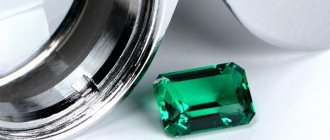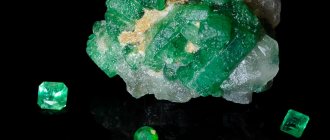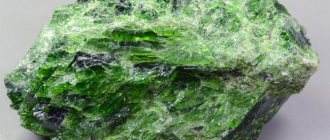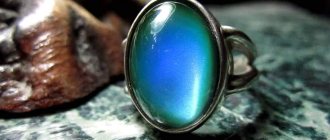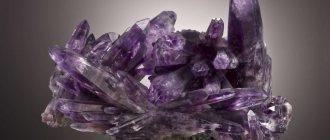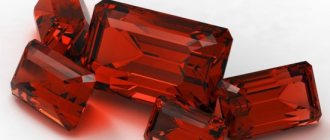Dioptase stone is a rare mineral from the group of copper silicates. Due to its remarkable dense grassy green color, it is called copper emerald. In contrast to this gemstone, it is more fragile and also has less hardness, which is why it is practically not used in jewelry.
Dioptase stone is a rare mineral from the group of copper silicates
History and origin
Deposits of dioptase arise during the weathering of rocks under the influence of a dry, hot climate in oxidized areas.
Mineral – Dioptase
At the end of the 18th century I.T. The catcher clearly demonstrated the difference between emerald and dioptase. Following him, detailed research was also carried out by R. J. Gayuy, and he gave the new stone a name. It literally translates as “one who looks through.” In the crystals of the stone you can see sparks of dense green or deep blue.
REFERENCE! Dioptase has many other names: copper emerald, green diamond, ashirite, kyrgyzite.
Copper emerald
Candidate of Geological and Mineralogical Sciences T. B. Zdorik Chemistry and Life No. 11, 1981, p. 39-40
At the end of the 18th century, a mineralogical wonder burst into Europe like a green comet: “emerald from the Kyrgyz steppes.”
In those days, the small hills of Central Kazakhstan were called the “Kyrgyz steppe”. Spacious, sunny and dry region. Everywhere, as far as the eye can see, the tops of the hills are round, white with sun-scorched grass. Here and there rocky outcrops peek out from the hills like small sharp manes.
About a hundred kilometers northwest of Karkaralinsk, Mount Altyn-Tyube (Altyntobe), now included in mineralogy textbooks, rises among the hills. From here, in 1785, the Bukhara merchant Mohammed Ashir Bey brought crystals of amazing beauty to Semipalatinsk: transparent, dense green and brightly shiny hexagonal columns with pointed tops. The green crystals were single or fused into intricate brushes and glowed in the sun brighter than emeralds. Their desperate green color, tinged with blue, was unusually elegant. Bright green sparkles sparkled from within. Emerald, well, pure emerald! A messenger flies to St. Petersburg, and the newly baked “emerald from the Kyrgyz steppes” captivates the capital’s connoisseurs. St. Petersburg academician Johann Ferber writes an article about him. And Brigadier Bentham, an Englishman in Russian service, rushes to Semipalatinsk. Having barely reached Altyn-Tyube and taken several samples with green crystals, the foreman was forced to retreat under the onslaught of nomads. And this time the green mineral was recognized as an emerald. Moreover, the “Kyrgyz variety of emerald” was given its own name - ashirit, in honor of the discoverer Ashir Bey.
A new expedition is heading to the Asian steppes. It is led by the famous Russian traveler G. F. German. He decides to carefully examine the mineral. Something confuses him about the new emerald. The edges of crystals are very easily erased, and sparkling cut gems become blind. He is very fragile. And really, is it an emerald? And the mineral is transferred for research to the remarkable St. Petersburg chemist, one of the first researchers of crystal growth, Tovius Lowitz. Contemporaries wrote that Lovitz’s scientific experiments were “not only significant, but also full of charm and exciting interest.” And now a disappointing analysis of ashirite has been obtained. Its resemblance to emerald is only external: almost half of the composition of the new mineral is copper, the rest is silicic acid and water.
Meanwhile, a new mineral from Russia has captured the attention of European experts. It is studied by one of the founders of crystallography, the French crystallographer Rene Juste Haüy. (It was he, Abbot Gaüy, who shortly before, in 1796, proved the relationship of the Peruvian emerald with beryl.) Accurate measurements of the angles between the faces of ashirite convinced Haüy that this time he was dealing with a completely new mineral: its crystalline cut was different, than emerald. The head of the crystals is especially different: it is flat in emerald, but in this mineral it is pointed and completed with a rhombohedron. Through the edges of the head, cleavage mirrors gleam obliquely. They give the mineral a festive and mysterious appearance. It is in them that the newcomer is extraordinary. And Haüy decides to rename the mineral after these cheerful green mirrors: dioptase (“dia” - in Greek “through”, “optisia” - vision). Gayuy's colleague, chemist Louis Nicolas Vauquelin, who also studied Peruvian emeralds and discovered a new element in them - beryllium, willingly repeated the analysis of dioptase from Russia. He also found in it a lot of copper and silicic acid in the complete absence of beryllium!
The “green miracle of the Kyrgyz steppes” created a sensation in Germany as well. Here Abraham Gottlieb Werner, a professor at the Freiberg Mining Academy, took up the project. The colors of minerals, their shades, their generalized appearance seemed to Werner to be the main elements of diagnosis. To emphasize the amazing external resemblance of the new mineral to emerald, Werner returns the mineral to its first name, but with an important adjective - copper emerald. This was the name for dioptase for a long time in Germany and Russia, especially in the Urals, where many German craftsmen worked in mining.
The literary history of dioptase is connected with the Ural mines. Here Pavel Bazhov collected and processed the tales of miners. Tales are not fairy tales. The power of their influence lies in the free combination of authenticity and fantasy.
The mountain both waters and feeds. The best moments of inspiration are given by the Mountain. But health and life itself go to the Mountain. “It’s bad for the one whom the Mistress of the Copper Mountain disliked, but it’s not sweeter for the one whom she loved” - this is the lei. But here’s what’s important to us now: both the love and hatred of the Mistress seem to crystallize in the pointed hexagons of copper emerald.
Copper emerald is like the Memory of the Mountain. It seems like you’re holding it in your hands, but you can’t turn it into worldly benefit.
In the tale “Sochnevy Pebbles,” full of contempt for meanness and money-grubbing, the copper emerald turns into the eyes of the owner’s black cats. But it’s true: bright dioptase is surprisingly similar to a cat’s eye glowing in the dark! You can’t imagine anything more accurate and more fabulous!
One of the founders of modern crystal chemistry, Academician N.V. Belov, studied the crystal structure of dioptase. Almost 150 years after Gayuya, it turned out that the external resemblance of the mineral to emerald was not at all accidental. It is due to the similarity of crystal lattices. Like emerald, dioptase is a ring silicate. In other words, the Si6O18 complex anions in both minerals have a ring structure. Ions of other elements (for emerald these are Be, Al, Cr, and for dioptase - Cu) are located between the rings. The color of emerald is due to one of the main dyes - chromium. Dioptase is colored with copper ions. Hence its bluish, somewhat sharp tint, often characteristic of copper compounds. (Just remember the blue crystals of copper sulfate.)
For a long time, dioptase was considered only a Russian stone.
But in our century it was found in Africa (Congo, Zaire, Namibia), in South America (Peru, Chile), in the southern states of the USA and in Romania. Mineralogists have found that transparent green crystals of dioptase are born where geochemical changes in copper ore deposits occur in a hot, dry climate. At first glance, the finds of copper emerald in the Urals seem to be an exception to this rule. It was as if they had really been bewitched by the Mistress of the Copper Mountain. But the harsh climate reigns in the Urals only in our days. The paleoclimate, the climate of the ancient Urals, the climate of the time of formation and weathering of copper-bearing deposits, was dry and hot, like in the deserts of South America. So the copper emerald is a messenger from the hot past. BACK
Place of Birth
For a long time Bukhara was considered the main deposit of the nugget. The stone was named after the merchant Ashar, on whose property it was discovered. Large deposits are also known in the following countries:
- Kazakhstan,
- Chile,
- Congo,
- USA.
In Russia, production is carried out in the Krasnoyarsk Territory and Transbaikalia.
However, natural crystalline dioptase is practically impossible to find in nature - it is mainly found in areas that have undergone oxidation.
Physico-chemical properties of stone
| Property | Description |
| Formula | Сu6[Si6О18]×6H2O |
| Hardness | 5 |
| Density | 3.28 - 3.35 g/cm³ |
| singonia | Trigonal |
| Kink | From stepwise uneven to conchoidal |
| Cleavage | Perfect |
| Shine | Glass |
| Transparency | Opaque |
| Color | From emerald green to dark green |
Appearance
Even though scientists consider dioptase to be only a natural counterfeit of a real emerald, but how beautiful it is. The color alone is worth it: from soft emerald to deep dark green. There is even green with a blue tint. All this combined with shine and translucency is admirable.
The characteristics of copper emerald are different from ordinary emerald. The density of ashirite is low. At the fracture, the edge of the crystal is stepwise uneven and conchoidal. However, it is a rare and valuable stone.
Areas of application
Dioptase is considered a rare stone: it is not easy to process due to its fragility and cleavage.
- Sometimes the products even use inserts made of untreated stone.
- As a mineral pigment it is also used in icon painting. The nugget is unable to become part of the color scheme, but when applied to other colors it helps to show areas with a transition of shadow and light. It is important to achieve this effect when depicting numerous folds on the clothes of saints.
- Rare samples of dioptase go into private collections.
Some historical facts
In the second half of the 18th century, merchant Ashir Zaripov discovered these stones in the mountains of Kazakhstan. He was sure that he had become the owner of real emeralds. The merchant sold them to an English officer, who at that time served in the Russian army. Several copies were brought to St. Petersburg. Here the find was named in honor of the merchant - the stone ashirite (asharite). Only eight years later, T. Lovitz, a Russian scientist, having carefully studied the mineral, found out that the find was not an emerald, but a copper silicate. Since then it has been called “pseudo-emerald”.
The famous mineralogist from France R. Gayuy gave the mineral its scientific name - dioptase, which consists of two Greek words. They can be translated as “observing through,” which characterize the translucency of the stone. Due to its resemblance to precious emerald, the mineral is used to make high-quality imitations of it.
During the reign of Catherine II, the dioptase stone was very popular at court. Any noble lady could boast of exquisite jewelry with inserts of raw crystals.
Medicinal properties
Our ancestors also talked about the healing power of stones. The following can be said about dioptase:
- Folk healers called it the heart stone and used it to strengthen blood vessels and treat heart diseases. This talisman is especially recommended for those who have suffered a heart attack. In such a situation, a pendant with this stone works best.
- Dioptase can also relieve excessive excitability, but at the same time have a positive effect on the overall tone of the body.
- It is also indispensable during pregnancy: the unborn child and the mother feel calm.
- Ulcers with dioptase heal much faster; for these purposes it was ground into powder;
- The stone helps in treating the upper respiratory tract.
- The green color of the nugget copes with stress and even psychological trauma.
- This is an indispensable healer for people with asthma, as well as those who suffer from regular colds.
Pendant with dioptase
Natural healer
The powerful energy of copper emerald has found application in lithotherapy. When heated, the mineral helps treat diseases of the upper respiratory tract, heart and blood vessels, relieves irritability, and calms the nervous system. Adherents of this treatment method believe that sessions with dioptase are indicated for pregnant women and patients who have suffered a heart attack or stroke. A pendant, brooch or amulet with a copper emerald is recommended to be worn at chest level by everyone who suffers from pathologies of the heart and blood vessels.
Dioptase improves the condition of respiratory tract diseases, including ailments affecting the trachea, throat and bronchi. In such a situation, it is advisable to wear an amulet with this mineral around the neck.
Traditional healers use ashirite powder to treat wounds that take a long time to heal. A brooch or pendant pinned to clothing helps ease breathing in people suffering from asthma. The healing properties of this mineral can relieve overexcitation and lift a person out of depression. To do this, you need to have a small crystal of a green healer with you.
Magic properties
In eastern magic, dioptase was used to create talismans for spouses. They were supposed to increase their virility. The following characteristics can also be distinguished:
- the mineral helps fight negative influences that come from others;
- protects from envious people;
- students and schoolchildren, with the help of such a talisman, increase the level of mental activity, tests and exams will be passed faster and more successfully;
- recommended for wearing by all those involved in law and economics;
- attracts wealth and prosperity;
- the talisman helps to understand the true intentions of business partners; if necessary, it will promptly bring them to light;
- with a strong connection with its owner, dioptase is able to read the thoughts of other people and transmit them to its owner in the form of symbolic clues.
REFERENCE! If you have difficulties in your personal life and disagreements with your partner, it is better to avoid wearing dioptase. It can only make the whole situation worse.
Feng Shui experts recommend placing the stone in the southeast of the apartment: this side is responsible for financial well-being. This is how positive energy flows are maximized.
Jewelry with mineral
Most often, the stone is cut into a cabochon or emerald cut. The resulting small crystals can then be used to create rings and earrings. In rare cases, it is used in exclusive jewelry in the form of crystal inserts or brushes.
Jewelry with stone
Jewelry houses exhibit rings, pendants, men's rings and pendants in their collections. Bracelets and beads are rare.
Varieties
The most common type of emerald has a light, slightly grayish, green color. This type is not very valued in jewelry, since products with them are not so bright and do not attract attention. But contrasting, shining stones of blue-green and malachite colors are popular and in demand. But not only green variations are available for sale, but also other colors.
The color of the emerald is determined by the place where it was mined (the best options are found in Colombia and the Urals). Transparent is valued the most. Density characteristics, classification and excellent appearance make it possible to put it on a par with diamonds.
But the classic emerald, in its color palette, can be yellow-green, blue-green, densely colored, saturated. Experienced jewelers can, just by looking at a stone, determine where on the planet it was mined. In particular:
- Options brought from Colombia have a grassy, forest-like hue. They are light, mostly opaque, without gas inclusions. They are considered the standard among beryls, which, by the way, are not emeralds.
- Stones are brought from Latin America that are unusual in their structure and texture. A distinctive feature is that the design imprinted inside resembles in appearance a snowflake or a flower, a wheel or the Universe. The variations are different, but it always looks beautiful.
- Emeralds mined in Zambia have a bluish glow. They are light, transparent, suitable for combination with silver in the form of a border.
- Variations with yellowish splashes are common in Australia. The appearance is unassuming, so they are rarely used in jewelry.
- Stones with a yellowish tint are brought from Brazil. But since light green is present, they are valued more than the previous option.
- From South Africa, emeralds are often not included in jewelry. The fact is that they are very light, the structure is cloudy.
- Emeralds mined in the Russian Federation are distinguished by their blue-green, rich color. Due to the inclusion of mica, they are opaque and hard.
By definition, an uncut emerald is a green stone. Shades are determined by hue, saturation and lightness. But, in any case, the base tone will be green, and nothing else. Options that are unusual in palette are other minerals that are mistaken for emeralds. Also, types of emeralds with unusual colors are obtained in laboratory conditions.
Important! The cost of the latter options can be significantly higher than natural stones.
Red emerald
Red emerald
Red emeralds exist. They are mined in limited quantities in the state of Utah in the United States. Few collectors can boast of such a raw stone in their arsenal. This is a rare variety; the cost of a beautiful gem reaches hundreds of thousands of dollars.
Products with red emeralds appeared on sale about 10 years ago. Do not think that these are natural stones. The fact is that red stones were created by Belarusian scientists. Instantly, such variations of emerald spread across the shelves of jewelry stores and attracted buyers.
Copper emerald
Copper emerald is called dioptase stone. They are similar in appearance. It has an emerald color, shimmers in the sun, glitters, and has a transparent structure with inclusions of gases.
But these types of stones are completely opposite in characteristics. Dioptase is characterized by increased fragility. In addition, copper silicate determines increased cleavage, which is not typical for natural emerald.
Copper emerald (dioptase)
Pink emerald
Amethyst, morganite, and beryl stones are called pink, milky emerald if they have a pinkish color. These are variations of standard beryl with the inclusion of manganese. Depending on its content, the structure and richness changes.
So-called pink emeralds are common in the jewelry industry. Beautiful jewelry is made with them, since the stone of a purple, peach tone goes well with gold.
Rainbow emerald
Tourmaline is called rainbow emerald. It is also green, blue, and similar in texture to emerald. But the differences relate to the structure - there are rainbow colors and shades, different in color scheme.
Tourmaline is widely used to create stylish jewelry. But it is also used to equip medical equipment in industry.
Black emerald
Black, blue emerald is called classic tourmaline, which contains a lot of iron. Other names: sherlit, sherl. Dark emerald is opaque, matte, reminiscent of obsidian. Producing mourning jewelry is a standard option.
Pink emerald
How to wear
This mineral can be worn by anyone if it suits their style, taste and appearance. Dioptase is not a very popular stone, so esotericists and scientists have not yet developed detailed recommendations on this issue. Women wearing dioptase jewelry become more sensual and attractive, and men become more decisive and independent.
In order not to make a mistake when choosing jewelry made of stones, experts advise choosing it wisely. To do this, you should hold the product you like in your hand, and then carefully listen to your own feelings. If you feel warm, this is a good sign; if it is cold, you should take a closer look at another symbol.
